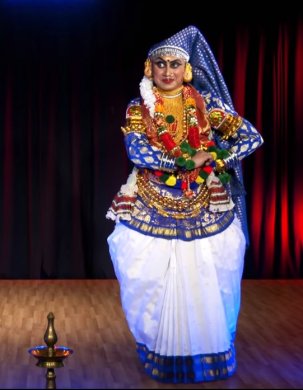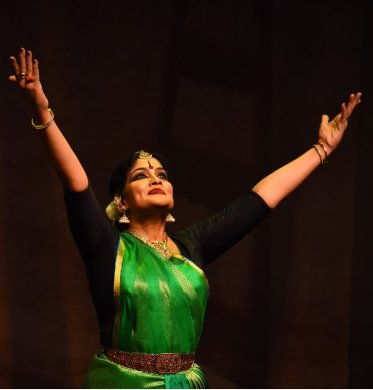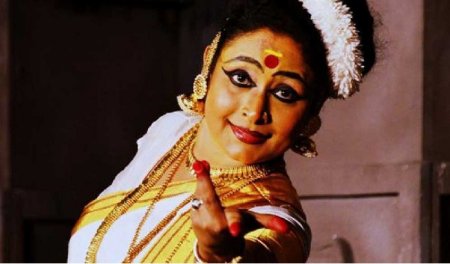
|   |

|   |
 e-mail: leelakaverivenkat@gmail.com West Zone Cultural Centre presents online Malhar Festival September 17, 2021 A celebratory festival marking seventy five years of India's 'Azadi Ka Amrit Mahotsav,' the four day virtual event Malhar organised by the WZCC at Udaipur, under the Cultural Affairs Ministry, began with a Kathakali performance pertaining to the traditional repertoire - which, for this critic, represents the best expression of this country's freedom - without having to be shackled to any special patriotic theme.  Prabal Gupta Prabal Gupta's deep involvement with Kathakali Streevesham, represents one of those rare instances of a non-Keralite presence - in a dance theatre form which derives its entire robust identity from being indigenously nurtured in the region of its birth - viz Kerala. His curtain raiser was an unusual Purappad, the nritta prelude for a Kathakali recital, rendered by the main character - in this instance the celestial dancer Urvashi. Rarely does one see amidst the hurried pace of performances today, where in this item, (in taal patterns set to chempada, triputa, muri adantha, panchali and jhampa) becomes a hurried formality, the circular, semi circular and lateral movements of the performer being rendered in such savoured leisure covering the entire performance space. The invocatory part with salutations to "Rama Palaya Maam Hare", who is the "Ravikula Soma," and "Neerada Shyama", which prayerful homage, pays tribute to Ramanatakam, the progenitor of Kathakali. This Purappad, newly composed by Prabal's guru Asan Sadanam Balakrishnan, seems a unique blend inspired by both the Kalluvazhi and the Kaplingadan Kathakali sampradayams. Accompanied by the melodic richness of singing in Shankarabharanam, Todi, Bhairavi and the invocation in Mohanam, "Manjutara kunjata kaeli sadane" rendering homage to Ashtapdiattam, by vocalists Sadanam Shivadas and Jyotish Babu, along with the dancer's aesthetic streevesham getup in white with blue border, the totality made for an arresting start. The main dramatic part of the recital was built on an episode from Nivatakavacha Kalakeya Vadham written by Kottayathu Thampuran. Arjuna, after winning the Pashupata Astram from Shiva, visits the abode of his father Indra, wherein, he sets free the celestial dancer Urvashi, by destroying the evil Vajra Ketu and Vajra Bahu. Promptly losing her heart to her valiant saviour, Urvashi's seductive advances to Arjuna, addressing her object of desire through fulsome praise, while declaring her feelings, prove fruitless. Arjuna, countering her advances, answers that he looks upon Urvashi, the wife of Pururava, as his mother, with whom he cannot consort. After all her earnest efforts fail, seething in the venom of a rejected woman, Urvashi curses Arjuna to become a eunuch. Prabal's mimetic conviction, owes a lot to the training under his Guru. The dancer has worked hard on the mobile cheek and eye movements of Kathakali. The dramatization convincingly brought out in the enactment, the phases of rising emotional storm. Starting with smitten Urvashi's unquenchable desire for uniting with this valorous hero ('with lips like ripe fruit' and 'brows like a bow', who in a trice can vanquish enemies) Urvashi, on his refusal, in the next stage, urges greater compassion, from one who as a "friend of Krishna and strong enough to confront even Shiva in battle" cannot harbour such a heart of stone. She rebuts his argument regarding the motherly relationship, pointing out that even his own Mother Kunti, enjoyed an amorous encounter with Surya (through whom she begot a son) and further, with Surya's son, Yama. When Arjuna remains unmoved by the advances, Urvashi turns into the enraged avenger, cursing him to turn into a eunuch - the only punishment for one who cannot respond to a beautiful woman's invitations.  Geeta Chandran Geeta Chandran's Bharatanatyam, with her own announcements in fluent Hindi mixed with a blend of English thrown in, was obviously tailor made for the occasion of the 75th year of Independence. She starting with the invocatory item dedicated to the Motherland, based on Mayuram Bhanu Vishwanath Sastri's salutation to India in Sanskrit, Jayati Jayati Bharata Mata in raga Kamas, a lyric greatly popularised by late famous Carnatic vocalist G.N. Balasubramaniam, which today has become a standard patriotic lyric rendered by eminent Carnatic vocalists. Geeta continued with a brief portrayal of facets of Vishnu (Om Namah Vishwaroopaya) based on kavya from Haveli Sangeet, which Geeta Chandran, given her strong credentials as a Carnatic vocalist, has worked on extensively. Practiced by the Pushtimarga sect and nourished in the Vraj Bhumi areas, these holy songs are in praise of Krishna/Vishnu. The dancer's selection for the evening "Om Namah Vishwaroopaya" in the form of a ragamalika, was an obeisance to facets of Vishnu - reclining on the ocean on his serpent bed. He is the lotus eyed one and the charmer with the flute mesmerising every living creature. He is also the destroyer of Kamsa and the joy of the Gopis, and the divine force one offers prayers to, for being guided and protected through the trials of life. The best of the recital, for this critic, came in the concluding two abhinaya compositions, aided by excellent musical support led by vocalists Sudha Raghuraman and Venkateshwar - musical excellence being a feature of Gita's presentations. Late scholar/ dancer and abhinaya expert Jamuna Krishnan (with whom Geeta worked on interpretative dance) researched deeply into the compositions of Vidyapati (1352-1448), the romantic poet from Mithila, Bihar area, referred to as "Maithi Kavi Kokil" whose works are in Maithily and Sanskrit. The lyric chosen for the recital "Kathanu Bedana Mohi Jaisi Madana" pictures the young lovestruck Gopi addressing Madana, the love God, wanting to know why he is aiming his love darts at one who is a simple Gopi, perhaps mistaking her for Shiva (whose third eye had burnt Madana to ashes) on whom he is seeking revenge. And there follows a complete description of how she, unlike Shiva, has no matted flowing locks but a flower bedecked plait, no third eye but just the vermilion mark, no garland of skulls, nor tiger skin draping the body, nor does she sport a blue throat or a serpent adorning her neck. The finale of the performance set to raga Ghanamashrama, was based on the poetry of Kabir, wherein the poet urges that man's preoccupation with the competitive rat race experienced all over, searching for the ultimate, is meaningless. Look within, he says, for divinity rests within you and give yourself the quiet to be able to listen and thereby experience this 'anahata naada' (cosmic sounds unheard and not perceived) inside. "Isi ghada undar anahata baje" says Kabir speaking of the body as the earthern pot which when patted gently emits vibratory sounds. Unless one gives oneself the quietude and the silence, this inner vibration of complete equanimity will remain unperceived. The way music and percussion conveyed the idea of inner silence was evocative and what with the singing by Venkatesh whose taanam passage with abstraction again beautifully conveyed the sense of 'anahata naada', along with Geeta's involved abhinaya, the item made for a fitting end.  Jayaprabha Menon In keeping with a dancer of a female centric form like Mohiniattam, Jayaprabha Menon's presentation of Su Shakti, a celebration of less known heroic heroines, was woven round deeds of valour, resilience and inner strength displayed by women from Kerala and other parts of India. Conceived and choreographed by Jayaprabha, the production was built on script and lyrics by Kavalam Padmanabhan Panikar and Ratna Panicker, with music composed by Kavalam Padmanabhan, Dr.Bindushri and Rama Devi. The dance, built round the central stylistic edifice of Mohiniattam had glimpses of Kalaripayattu, Chhau, Bharatanatyam and of nondescript Manipuri like movements, obviously to capture the feel of regional identities of the chosen heroines. The sensitively conceived music anchored on the fluid male voice of singer Rajagopal, also comprised group singing sequences by female voices of songs and melodies typical to various regions, instrumental interludes on flute (Raghuraman's flute interventions in particular), veena and nritta spells constructed on a variety of pure percussion, with linkages from scene to scene, all very smoothly blended. The opening sequence was with Kavalam Narayana Panikar's Mukhachalam in ragamalika rendered by an admirably coordinated group of students of Jayaprabha. After the Pantuvarali start, nritta sequences in Reetigowla ending with "vastu purusha tilakam" in Neelambari with the Dhit dhit dhit dhit tai tai taka syllables, came the ritualistic celebration of Kerala's Kamadev puja - the Mother and daughter duo (Rohini Pauduwal and Keerthana Nair) with women companions dancing in joy with the music set to Kambhoji, celebrating the young maiden's attainment of puberty. Addressing the "Kanni penne" the loving mother advises that the fragrance of beauty should chime with righteousness, as the motto for life. Typical Keralite group singing introduces Unniacha of the Cheguvar family, one of the greatest women warriors of Kerala, adept in Kalaripayattu and the use of the special urumi sword. The choreography rendered to edakka percussion with the slow attack and defence movements with dancer Thankam Krishnan in the role as the heroine, had a leisurely grace. A sterling example of state craft and intelligence, came next in the form of Nayika Devi (dancer Niveditha C), whose ploy of planned resistance against invader Mohammad Ghori, comprised challenging the invaders at the site of the mountain terrain she was very familiar with. So badly beaten was Ghori that he never ventured near the Chalukyan kingdom again. The movement visualisation with rhythmic accompaniment on cymbals and drums saw sword wielding female dancers getting the better of male Chhau dancers. Krishnapriya Nair made a convincing Keeladi Chinamma, who, after brief married bliss with Somashekhar Nayak, loses her husband to the wiles of a seductress (played by Jayaprabha Menon). Not allowing herself to be overcome by the situation, she however inspires the subjects to unite and fight the attacking forces. Brought up with training in martial arts and Kalaripayattu by the father, Madileri Kanni becomes the wife of the Raja of Venad, who falls in love with her. But immediately after follow three long years of separation from her husband who, according to tidings reaching Kanni, is losing the battle against the enemy. Donning battle gear, and disguising herself, Kanni succeeds in driving away the invaders - a fact she never discloses to her husband. The music in Kamas conveying sringar bliss, changes to Sahana communicating the pangs of long separation, to end with the percussive fare with drums and cymbals for the scene of Madileri proving triumphant over the attackers. Maharani Tarana Tara Bai, whose martial accomplishments protect her kingdom, succeeds in keeping even the mighty Aurangzeb at bay. Dancing to spirited nattuvangam is the scene of Shiva Gangai known as Velu Nachiyar, who sacrifices herself tying a bomb to her body to destroy and blow up the enemy. Aparna Sajeev, the Bharatanatyam dancer cast in the role, one felt, needed to inject more of the assertive quality into the linear dimensions of her movements in Bharatanatyam. Eloquently evocative of both courage and piety, was the brief scene of Neha Singh as Mata Bhog Kaur - the music comprising recitational passages from the Guru Granth Saheb, the holy book of the Sikhs. Nupi, the concluding part, is dedicated to the collective force of unsung women warriors in Manipur protesting against the British imposed Lalup system, shown with a small group of women, rendering Manipuri like soft movements to rhythm on the pung. Summing up this tribute to countless unsung glories of the past, compere Sadhana Srivastav in her introductions quoted Tyagaraja's opening line from one of his famous Pancha Ratna Kritis "Entaro Mahanubhaavulu, antariki vandanamulu" in raga Sri, echoing this very sentiment. The very elegantly planned costumes, with clever touches like using the frills and fan to cover and adorn the right half of the upper body (the rest of the costume with the straight draping without frills of the off-white and white much like the mundu, while preserving the Keralite Mohiniattam identity with the top hair knot on one side) was an excellent idea. The turban for the Sikh, the Chhau costume and chudidar wearing male invaders, and some other characters like the temptress and Velu Nachiyar in Bharatanatyam kacha costume, introduced colourful changes in the general off-white colour scheme. Tailormade for an occasion like Azadi Ka Amrit Mahotsav was Kalakshetra's Bharatanatyam event 'Veera Sudandiram'. What better than to portray the theme of Independence woven on the textual framework of poetic compositions and lyrics of Kavi Bharatiyar, whose songs have been standard fare for marking patriotic occasions - rendered by the best of Carnatic musicians. The production was presented as the rounding off, of a Yuva Nritya Utsav held in Kalakshetra. A man of many parts, Bharatiyar's poetry covered social, political and spiritual concerns. His fiery compositions kindling patriotism, his fight for emancipation of women and abolishing of child marriage, his secular credentials and desire to reform religion by removing caste inequalities, his passion for India's educational progress, and advancement in all fields expressed in the vigour of prose and poetry, have given Bharatiyar the place of one of the country's renaissance figures. In typical Kalakshetra mould, the production left no aspect of Baratiyar's poetry in relation to the country's fight for independence uncovered. Founded on a sound musical base comprising musicians K.R. Rakesh (nattuvangam), Hariprasad (vocal), Anil Kumar (mridangam), Pakal Ramdas (violin), Sashidhar (flute) and Anantanarayanan (veena), the songs set to rakti ragas like Nattai, Arabhi, Mohanam, Behag, Athana, Kamas, Shanmukhapriya, Sama, Begada, Bhairavi, Madhyamawati, Kalyani, Vasanta et al to name a few, provided inspiring support. The coordinated musical effort apart, the manner in which solfa passages and rhythmic syllabic passages like tillana are interspersed at points, brings in changes in mood, providing the dancing with special zest. Starting off with cries of freedom, with songs like Vande Mataram enbom, Veera Sudandiram, Parukkulle nalla naadu, the opening sequences hailed freedom for our motherland, with its rich heritage of learning, philosophy, poetry and art, as the only desire of every countryman. Portraying the people of this land, as the great inheritors ofa spirit of compassion and charity, the anna daanam scenes of feeding and being blessed (down to the last detail of laying the banana leaf for the three seated guests with each dish being served and actions imitating the entire process of eating, with the satiated finally blessing the benefactors) were far too literal for an ensemble of Kalakshetra - certainly capable of more suggestive and poetic interpretation in the dance! The Bharatiyar song hailing India's rich physical geography, pays salutations to the mighty Himalayas bounding the North, the source of the river Ganga, which has cradled so many civilizations. Bharati's compositions express what the country will strive for in a free India - with advancement in education, in agriculture and industry. An admirer of freedom fighter V.O.Chidambaranar (named Kappalottiya Tamizhan - the Tamilian who navigated ships), one of Bharatiyar's poems treated in the production, is in reference to this leader of the Congress, who as the ship building Indian pioneer started Swadeshi Steam Navigation Company in 1906 between Tuticorin and Colombo, to fight the British monopoly of British India Steam Navigation. The song Kadal muzhuvadum kappal viduvom interpreted by a group of dancers, visualised Indian ships covering the seas. In true Kalakshetra style, followed the scenes of freedom fighters fearlessly defying (Achhamillai achham onrum illaiya) while being brutally assaulted by a group of police forces. There being little scope for any individualistic improvisatory element in the theme, ensemble movements, even in the stick twirls of the British security forces, tend to create a sense of the already seen, following a stereotypical pattern. The tortures of prison and struggling freedom fighters Kanneer vittom, valarttom sarvesha is followed by Gandhi's (very well profiled in the performer as the Mahatma) blessings with the comforting message of Independence being round the corner. The final sequence is the triumphant declaration of Independence and rejoicing - Vidudalai, Vidudalai, Vidudalai! Bharatiyar's poetry expresses thoughts and opinions of even diverting excess waters to needy areas and a bridge construction as link to Sri Lanka - all demonstrating his deep involvement with issues of the nation. As usual, with every minute detail spelt out, with impeccably correct movements in each performer, the work presents a well knit, if predictable, look.  Writing on the dance scene for the last forty years, Leela Venkataraman's incisive comments on performances of all dance forms, participation in dance discussions both in India and abroad, and as a regular contributor to Hindu Friday Review, journals like Sruti and Nartanam, makes her voice respected for its balanced critiquing. She is the author of several books like Indian Classical dance: Tradition in Transition, Classical Dance in India and Indian Classical dance: The Renaissance and Beyond. Post your comments Pl provide your name and email id along with your comment. All appropriate comments posted with name and email id in the blog will also be featured in the site. |